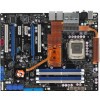- Qualcomm Launches Snapdragon 4 Gen 2 Mobile Platform
- AMD Launches Ryzen PRO 7000 Series Mobile & Desktop Platform
- Intel Launches Sleek Single-Slot Arc Pro A60 Workstation Graphics Card
- NVIDIA Announces Latest Ada Lovelace Additions: GeForce RTX 4060 Ti & RTX 4060
- Maxon Redshift With AMD Radeon GPU Rendering Support Now Available
ASUS Maximus Formula Special Edition

We took a look at the Blitz Formula and Extreme boards from ASUS just over two months ago, and now we have the X38 version of those boards on the bench today. In addition to featuring a Northbridge waterblock, it also has “extreme” overclocking ability and a great bundle.
Page 3 – The BIOS
Where an enthusiast motherboard is concerned, the BIOS is one of the more important aspects, one that can make or break the overclocking ability. Luckily for us, ASUS never fails to go completely overboard with their higher-end boards, and the Maximus Formula is no different. Before we take a look at the overclocking-specific options, let’s first take a quick stroll through the other portions of the BIOS.
The opening BIOS screen features the usual slew of options you’d expect, from date and time to installed hard-drives. To view quick system information (eg: to see if you have the correct CPU installed), you can go into the System Information section at the bottom.
The Maximus Formula wastes no time getting into the options that overclockers are after. At default, all options will be set to auto, with the FSB Frequency being set to the appropriate setting, depending on the installed processor. The top portion of this section is dedicated to CPU and DRAM clocks, in addition to your FSB strap, which I found no benefit in touching on this board.
Scrolling down the page, you will quickly reveal all of the various memory timing options that are available. Though I love to overclock memory, I admit that I have no desire to get that tweak-happy. But if your goal is having your memory operate at it’s absolute best, you could easily spend hours, or days, on these options alone.
Moving even lower reveals all of the various voltage options, of which there are many. If you read our Blitz Extreme and Formula review in late July, you saw just how ridiculous the voltage options were. The Maximus Formula takes things to an even higher level:
- CPU Voltage: 1.10000v – 1.90000v
- CPU PLL: 1.50v – 3.00v
- Northbridge: 1.25v – 1.95v
- Southbridge: 1.050v – 1.225v
- DDR2 RAM: 1.80v – 3.40v
- FSB Termination: 1.20v – 2.00v
If you manage to not kill your computer with the insane voltage options, you can also configure the on-board LEDs, which are color-coded depending on how asinine your selected voltage is.
Here are a few more BIOS shots that most here should already be well familiar with:
The Power section is one of the best I’ve seen with temperature listings for the CPU, MB, NB and SB… quick and useful information. I referred to this page after each reboot if I increased the voltage, to make sure temperatures were still in check.
Moving to the bottom of this page is even more useful, as it reports the real voltage that’s being sent off to each component. I always found that the NB voltage here was higher than what was actually set, so it’s wise to check here after each reboot for that reason. You don’t want to go overboard by accident.
The last BIOS feature worth mentioning is one that I wish all motherboards included… the ability to flash your BIOS from within the BIOS using a thumb drive or some other FAT32 partition. It makes things easy. You download the latest BIOS, copy it to your thumb drive, reboot into the BIOS and minutes later you are using the latest version.
As far as enthusiasts are concerned, there is nothing lacking in this BIOS at all… and if there is, it is likely to be a feature that the absolute few would be interested in. Next we will tackle our testing methodology and jump right into our testing results.
|
|
Support our efforts! With ad revenue at an all-time low for written websites, we're relying more than ever on reader support to help us continue putting so much effort into this type of content. You can support us by becoming a Patron, or by using our Amazon shopping affiliate links listed through our articles. Thanks for your support!















